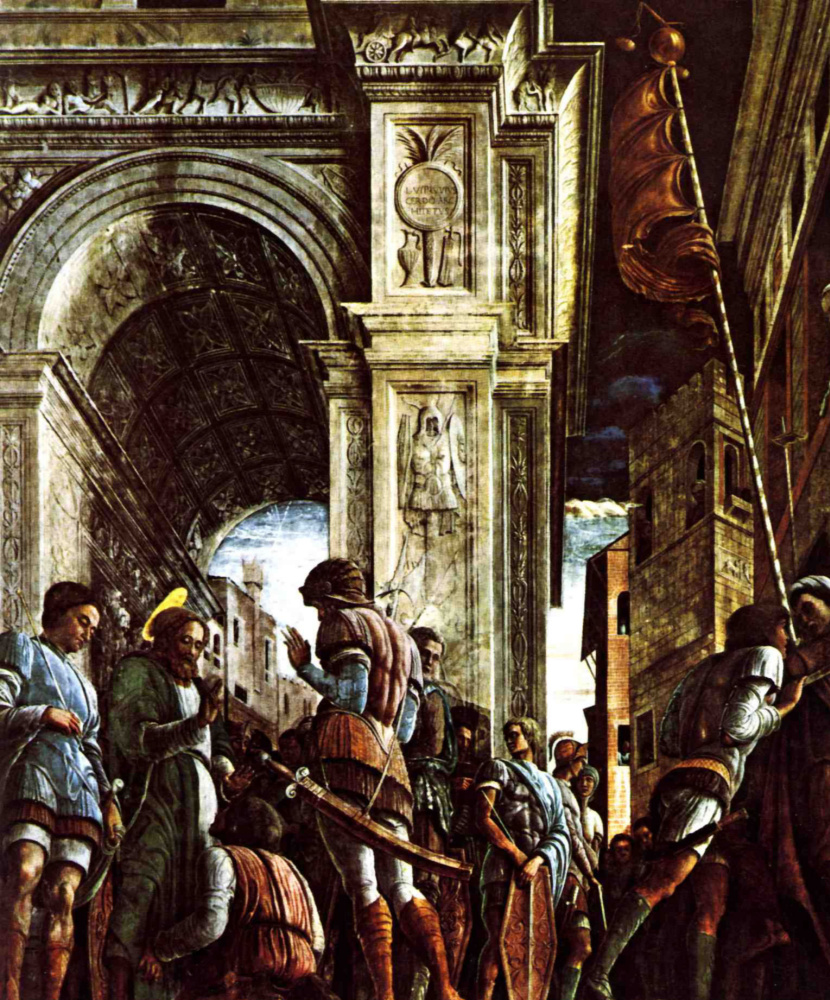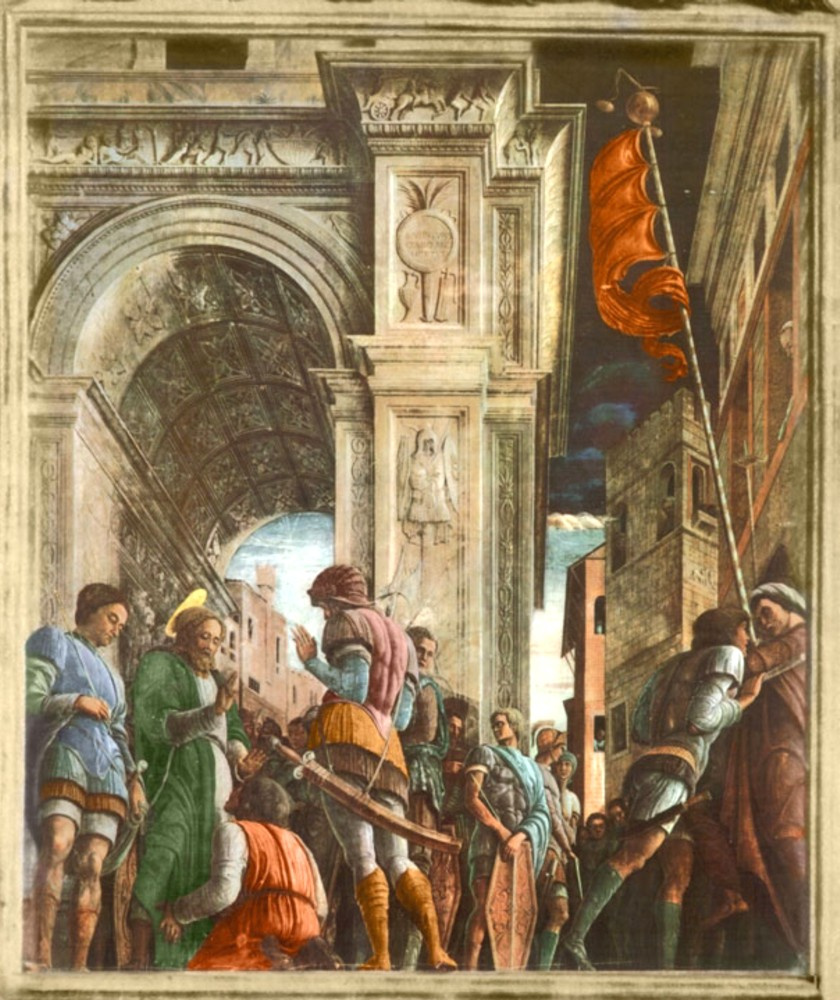log in
Enter site
Login to use Arthive functionality to the maximum
The procession of St. James to the penalty. The fresco of the chapel of Ovetari in the Church of the Eremitani in Padua
Andrea Mantegna • Painting, XV century
Description of the artwork «The procession of St. James to the penalty. The fresco of the chapel of Ovetari in the Church of the Eremitani in Padua»
"The procession of St. James to death" - mural made a young, 25-year-old Andrea Mantegna for the chapel of Ovetari of the complex of the Church of the Eremitani in Padua (end of the 1440 - 1450-ies).
A bit of historical context
Created by monks, Augustinians in the middle of the XIII century, this temple complex is the center of attraction for those who come to Padua, and wants to see its artistic treasures. First and foremost, of course, see the Scrovegni chapel – it was painted along with a great team of apprentices Giotto.
But the second choir – chapel Ovetari, on the frescoes where he worked Andrea Mantegna, to see, unfortunately, will not work. During the Second world war, she was greatly affected and its destruction is considered to be one of the biggest cultural losses of Italy in the war. Napoleon's troops, located in the early NINETEENTH century in the Church of the Eremitani their barracks, also damaged its interior, but after the bombing raids of the 1940s from the frescoes by Mantegna were some fragments.
One consolation is that the painting was so superb that they are very often copied, so we to some extent can imagine, looked like the lost frescoes of the chapel of Ovetari. Particularly noteworthy are scenes from the lives of St. James and St. Christopher. Well, "the Procession of St. James to death" - generally the best part of the whole fresco cycle. No self-respecting "History of art" or a tutorial of the picture is not complete without a detailed analysis of the frescoes by Mantegna.
What are the advantages and novelty of the fresco "the Procession of St. James to death," or Mantegna as a Director
The brother of Jesus according to the flesh, Jacob was in the death of Christ sent to preach in Judea – the area most opposed to the spread of Christianity. It was Jacob who made the Liturgy with some reductions Christian churches serve to this day. He also performed miracles of healing, but for loyalty to the Christ was executed by the high priest and Pharisees annoy through stoning. Many ancient writers even believed that the destruction of Jerusalem is a punishment from God for the execution of the brother of the Lord James.
SV.Jacob lived in the time of the Roman Empire. To get into the spirit of the period, Mantegna studied ancient reliefs and sculpture. Monumental building in the background of the mural – this is a triumphal arch in Rome. This geographical shift was the art of the Renaissance thing in common.
Optical effects and possible perspectives that the artist knew, important to Mantegna, not by themselves. With their help, he arranges on a flat surface of the wall kind of scenes with moving figures surround. But also made sculptural credibility obviously not enough. Mantegna is directing the whole mise-EN-scene, placing characters, as an experienced playwright.
Logically, in the center of the composition would have to be Jacob. But no! The Holy moved into the left corner and in the center of our attention are the soldiers-the guards in Roman armor and the impression on them has a miracle, produced by James. One of the soldiers suddenly believed and rushed to the feet of the Holy, and he makes it the sign of the cross. In this scene Mantegna is the reaction of others to what is happening.
The warrior in the center of the fresco shown in the complex view and from the back. He like jumped back and froze in amazement. The other two in the right corner whispering, passing each other sensation (them the shocked faces we can see on the fragment). Perspective foreshortening from below leads to the fact that the figures in the mural seem giant. Due to the very low point of view they seem to "fall out" of the plane of the wall. And fragments of sky and city buildings create the illusion of the lack of walls.
Such spatial solutions Mantegna for his time, was extraordinary and extraordinarily brave.
Author: Anna Yesterday
A bit of historical context
Created by monks, Augustinians in the middle of the XIII century, this temple complex is the center of attraction for those who come to Padua, and wants to see its artistic treasures. First and foremost, of course, see the Scrovegni chapel – it was painted along with a great team of apprentices Giotto.
But the second choir – chapel Ovetari, on the frescoes where he worked Andrea Mantegna, to see, unfortunately, will not work. During the Second world war, she was greatly affected and its destruction is considered to be one of the biggest cultural losses of Italy in the war. Napoleon's troops, located in the early NINETEENTH century in the Church of the Eremitani their barracks, also damaged its interior, but after the bombing raids of the 1940s from the frescoes by Mantegna were some fragments.
One consolation is that the painting was so superb that they are very often copied, so we to some extent can imagine, looked like the lost frescoes of the chapel of Ovetari. Particularly noteworthy are scenes from the lives of St. James and St. Christopher. Well, "the Procession of St. James to death" - generally the best part of the whole fresco cycle. No self-respecting "History of art" or a tutorial of the picture is not complete without a detailed analysis of the frescoes by Mantegna.
What are the advantages and novelty of the fresco "the Procession of St. James to death," or Mantegna as a Director
The brother of Jesus according to the flesh, Jacob was in the death of Christ sent to preach in Judea – the area most opposed to the spread of Christianity. It was Jacob who made the Liturgy with some reductions Christian churches serve to this day. He also performed miracles of healing, but for loyalty to the Christ was executed by the high priest and Pharisees annoy through stoning. Many ancient writers even believed that the destruction of Jerusalem is a punishment from God for the execution of the brother of the Lord James.
SV.Jacob lived in the time of the Roman Empire. To get into the spirit of the period, Mantegna studied ancient reliefs and sculpture. Monumental building in the background of the mural – this is a triumphal arch in Rome. This geographical shift was the art of the Renaissance thing in common.
Optical effects and possible perspectives that the artist knew, important to Mantegna, not by themselves. With their help, he arranges on a flat surface of the wall kind of scenes with moving figures surround. But also made sculptural credibility obviously not enough. Mantegna is directing the whole mise-EN-scene, placing characters, as an experienced playwright.
Logically, in the center of the composition would have to be Jacob. But no! The Holy moved into the left corner and in the center of our attention are the soldiers-the guards in Roman armor and the impression on them has a miracle, produced by James. One of the soldiers suddenly believed and rushed to the feet of the Holy, and he makes it the sign of the cross. In this scene Mantegna is the reaction of others to what is happening.
The warrior in the center of the fresco shown in the complex view and from the back. He like jumped back and froze in amazement. The other two in the right corner whispering, passing each other sensation (them the shocked faces we can see on the fragment). Perspective foreshortening from below leads to the fact that the figures in the mural seem giant. Due to the very low point of view they seem to "fall out" of the plane of the wall. And fragments of sky and city buildings create the illusion of the lack of walls.
Such spatial solutions Mantegna for his time, was extraordinary and extraordinarily brave.
Author: Anna Yesterday




